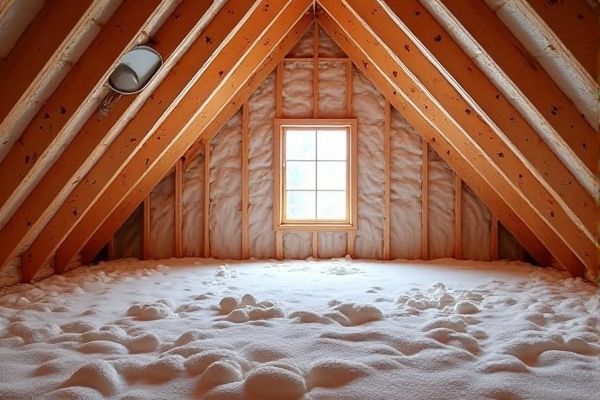
Spray foam insulation provides superior air sealing and higher R-values per inch compared to blown-in insulation, making it more effective for reducing energy costs and improving indoor comfort in your attic. Discover the key differences, benefits, and installation considerations to determine which option best suits your home's needs in the rest of this article.
Table of Comparison
| Feature | Spray Foam Insulation | Blown-In Insulation |
|---|---|---|
| Material Type | Polyurethane foam | Loose cellulose or fiberglass |
| R-Value (per inch) | 6.0 - 7.0 | 3.2 - 3.8 |
| Air Sealing | Excellent - acts as air barrier | Moderate - less effective air barrier |
| Installation | Professional application required | Can be DIY or professional |
| Cost | Higher ($1.50 to $3.00 per sq ft) | Lower ($0.50 to $1.50 per sq ft) |
| Moisture Resistance | High - resists water and mold | Low - prone to moisture absorption |
| Longevity | 20+ years with minimal degradation | 10-15 years, may settle over time |
| Environmental Impact | Uses chemicals, some off-gassing | Made from recycled materials, biodegradable |
| Best Use | Air-tight sealing in new or existing attics | Adding or topping up attic insulation |
Introduction to Attic Insulation Options
Spray foam insulation provides superior air sealing and higher R-values per inch compared to blown-in insulation, making it ideal for maximizing energy efficiency in attics. Blown-in insulation, commonly made from cellulose or fiberglass, offers a cost-effective solution that fills irregular spaces and provides good thermal performance. Homeowners must consider factors such as budget, attic ventilation, and moisture control when selecting between spray foam and blown-in attic insulation.
What is Spray Foam Insulation?
Spray foam insulation is a high-performance material composed of polyurethane that expands upon application to create an airtight seal in attics, preventing heat loss and air infiltration. It offers superior R-values per inch compared to blown-in insulation, providing enhanced thermal resistance and moisture control. This insulation type adheres directly to surfaces, filling gaps and cracks more effectively than loose-fill options, resulting in improved energy efficiency and durability.
What is Blown-In Insulation?
Blown-in insulation consists of small particles of fiberglass, cellulose, or mineral wool that are mechanically blown into attics to fill gaps and create a thermal barrier. This type of insulation is ideal for retrofitting existing attics as it can easily conform to irregular spaces and densely cover surfaces. Blown-in insulation provides excellent air sealing and improves energy efficiency by reducing heat transfer in residential and commercial buildings.
Installation Process: Spray Foam vs Blown-In
Spray foam insulation involves a chemical reaction that expands upon application, creating an airtight seal and requiring professional equipment for precise spraying. Blown-in insulation is installed by mechanically blowing loose fibers or pellets into the attic space through holes in the ceiling, allowing for quicker, less invasive coverage but potentially leaving gaps if not evenly distributed. Spray foam typically offers higher R-values per inch and better air sealing, while blown-in insulation is favored for its ease of installation and lower upfront cost.
Energy Efficiency Comparison
Spray foam insulation provides superior energy efficiency in attics by creating an airtight seal that minimizes air leakage and thermal bridging, resulting in higher R-values per inch compared to blown-in insulation. Blown-in insulation, typically made of fiberglass or cellulose, offers good coverage and fills cavities effectively, but its lower density and potential gaps can lead to more heat loss. Choosing spray foam can significantly reduce your energy bills by improving overall thermal performance and moisture resistance in your attic space.
Cost Differences and Budget Considerations
Spray foam insulation generally has a higher upfront cost, averaging $1.50 to $3.00 per square foot, compared to blown-in insulation, which typically costs between $0.50 and $1.50 per square foot. Budget considerations should include long-term energy savings, as spray foam's superior air sealing can reduce heating and cooling expenses over time. Homeowners with limited initial funds might prefer blown-in insulation for its affordability, while those seeking maximum thermal efficiency and durability may invest more in spray foam despite the higher price.
R-Value and Thermal Performance
Spray foam insulation offers a higher R-value per inch, typically around R-6 to R-7, compared to blown-in insulation, which ranges from R-2.2 to R-3.8 per inch, resulting in superior thermal performance and air sealing in your attic. Its ability to expand and fill gaps reduces thermal bridging and air leaks, enhancing energy efficiency. Choosing spray foam insulation can significantly improve your home's temperature regulation and lower energy costs over time.
Air Sealing Capabilities
Spray foam insulation provides superior air sealing capabilities compared to blown-in insulation due to its ability to expand and fill gaps, cracks, and crevices, creating an airtight barrier in your attic. Blown-in insulation primarily acts as a thermal barrier but may leave small air leaks or voids that allow drafts and reduce energy efficiency. Choosing spray foam enhances your attic's overall air sealing, minimizing heat loss and improving indoor comfort.
Longevity and Maintenance
Spray foam insulation offers superior longevity, often maintaining its effectiveness for over 80 years with minimal maintenance due to its rigid, air-sealing properties. Blown-in insulation, such as cellulose or fiberglass, typically lasts 20-30 years but may require periodic topping up or replacement to address settling and moisture issues. Your choice impacts long-term energy efficiency and maintenance frequency, with spray foam providing a more durable, low-maintenance solution for attic insulation.
Which Insulation is Best for Your Attic?
Spray foam insulation offers superior air sealing and higher R-values per inch, making it ideal for tight attic spaces where maximizing energy efficiency is crucial. Blown-in insulation provides easier installation and cost-effectiveness, covering irregular areas quickly but may settle over time, reducing effectiveness. Assess your attic's structure, budget, and long-term energy goals to determine which insulation best suits your needs.
 homyna.com
homyna.com